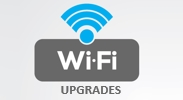We’ve come a long way in the past decade. The UVic Wireless Network (“UVic AirNet”) was established as a pilot project in the early 2000’s with the introduction of a limited number of hot-spots in the McPherson Library. In the early years, demand grew slowly, mostly driven by student use of laptop computers. The UVic Wireless Network was expanded to include more locations, but still followed the hot-spot deployment model.
In 2008, there was a radical shift in how people used wireless networking. Mobile “always-connected” devices such as the iPhone began coming onto the scene. The stop ‘n go usage pattern of laptops was being usurped by an on-the-fly model: students no longer sat in one place to use the Internet, they used it everywhere — even while walking between classes! This drove the need for both ubiquitous and contiguous coverage on campus. In response, Network Services spent the summer of 2008 revamping the campus wireless infrastructure, moving to a model which would allow us to respond to rapid growth in demand and increased mobility. It was just in time delivery: the beginning of the Fall Term that year saw a doubling of wireless usage over the peaks from the spring of that year – it became common to see 4,000 people signed-on during busy days.
Use of campus wireless continued its upward trend: more than doubling in the Fall of 2009 with another significant up-tick in 2010. By October of 2012, it was common to see 13,000 concurrent connections to wireless during peak times (11am-2pm, Tues-Thurs). Hand-in-hand with this growth was an expansion of the network to extend wireless network coverage to almost every square foot of every building on campus.
In 2013, we again find ourselves in the midst of an overhaul of our wireless infrastructure: in the past 6 months, Network Services has replaced over 90% of the 1,034 wireless access points on campus. The new equipment allows us to offer current standards (such as 802.11n or “N”) more broadly, as well as position us to adopt emerging standards (e.g. 802.11ac). In short: better, faster, stronger connectivity.
What’s next?
Network Services has recently begun surveying to measure signal coverage across campus. This will help isolate areas of heavy usage or poor signal quality, which can then be improved through system tuning or the installation of additional equipment. This process is very time consuming as it involves pacing the hallways (and lecture theatres, classrooms, cafeterias, …) of every building with test equipment – and there are a lot of buildings on this campus!
Plans are also in the works to start improving outdoor coverage. Popular outdoor gathering places will be attended to first, including: Petch Fountain, Bus Terminal, and patio areas surrounding the Student Union Building and MacLaurin Building.
Later this year, once all of the remaining older-generation access points are upgraded, we will be better positioned to offer new services to campus such as native-mode IPv6 and support for AppleTV.

